Analyzing Job Training's Effect on Employee Performance Levels
VerifiedAdded on 2023/06/11
|30
|8258
|174
Report
AI Summary
This research report investigates the impact of paid on-the-job training on employee performance. It begins by establishing the background context, research problem, aims, objectives, and significance of the study, as well as the scope of the report. The literature review explores the importance of job training, its effect on employee performance, and the theoretical framework underpinning the research. The methodology section details the research philosophy, approach, design, sampling techniques, data collection methods, and analysis procedures, while also addressing ethical considerations and research limitations. The discussion and analysis section presents findings related to the correlation between job training and employee performance. The report concludes with recommendations for organizations to enhance their training programs and a summary of the key findings. Appendices include interview transcripts providing further insights into the topic. This report is available on Desklib, along with a variety of study tools for students.
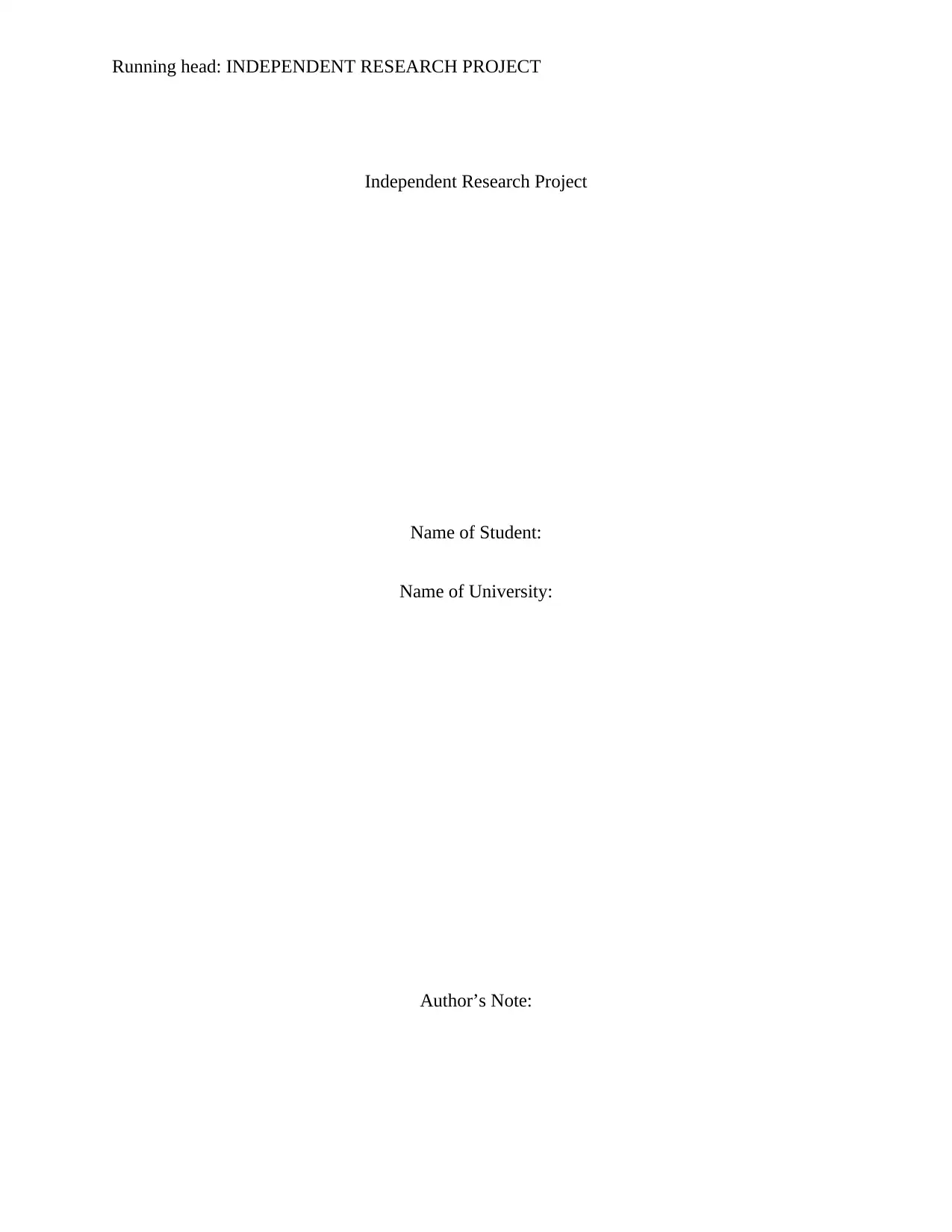
Running head: INDEPENDENT RESEARCH PROJECT
Independent Research Project
Name of Student:
Name of University:
Author’s Note:
Independent Research Project
Name of Student:
Name of University:
Author’s Note:
Paraphrase This Document
Need a fresh take? Get an instant paraphrase of this document with our AI Paraphraser
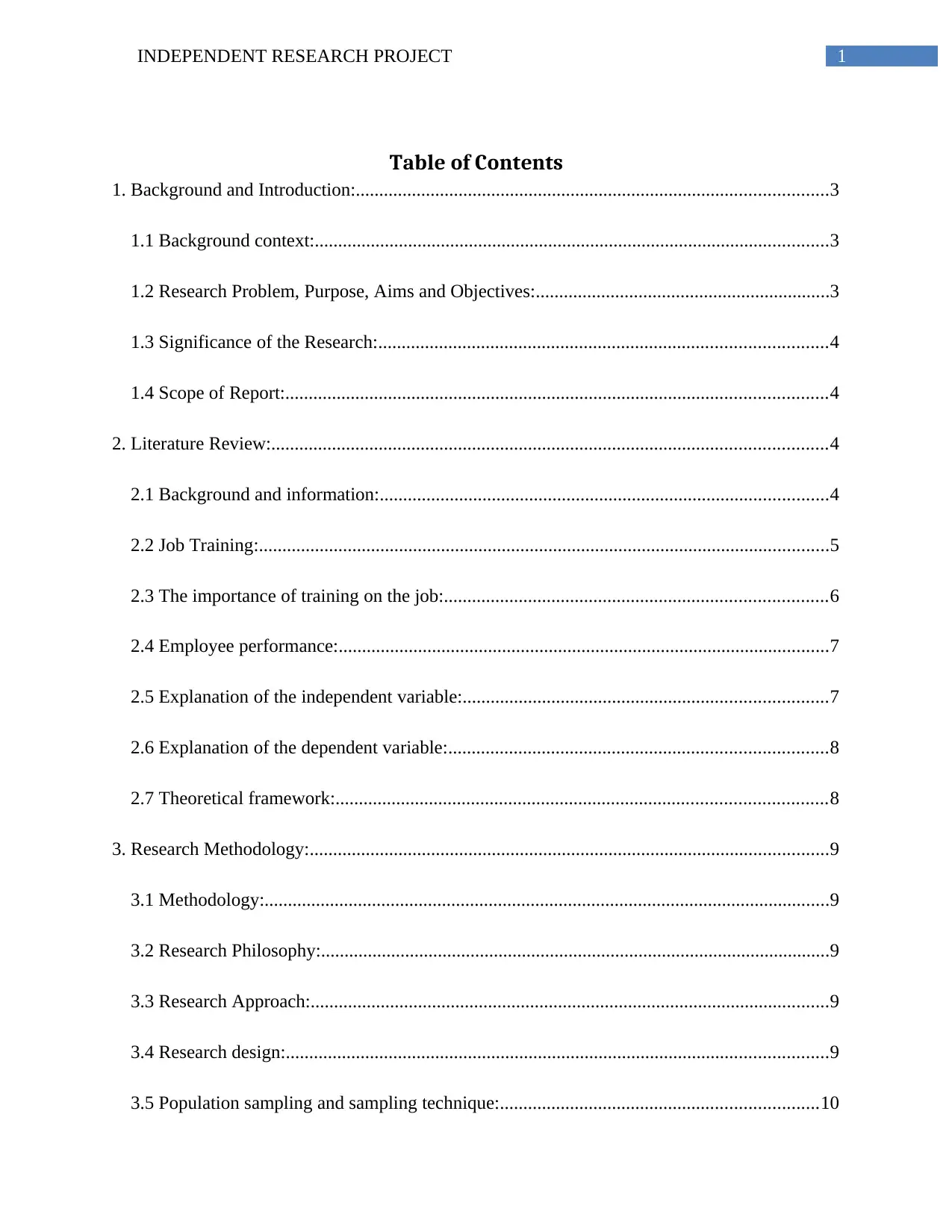
1INDEPENDENT RESEARCH PROJECT
Table of Contents
1. Background and Introduction:.....................................................................................................3
1.1 Background context:..............................................................................................................3
1.2 Research Problem, Purpose, Aims and Objectives:...............................................................3
1.3 Significance of the Research:................................................................................................4
1.4 Scope of Report:....................................................................................................................4
2. Literature Review:.......................................................................................................................4
2.1 Background and information:................................................................................................4
2.2 Job Training:..........................................................................................................................5
2.3 The importance of training on the job:..................................................................................6
2.4 Employee performance:.........................................................................................................7
2.5 Explanation of the independent variable:..............................................................................7
2.6 Explanation of the dependent variable:.................................................................................8
2.7 Theoretical framework:.........................................................................................................8
3. Research Methodology:...............................................................................................................9
3.1 Methodology:.........................................................................................................................9
3.2 Research Philosophy:.............................................................................................................9
3.3 Research Approach:...............................................................................................................9
3.4 Research design:....................................................................................................................9
3.5 Population sampling and sampling technique:....................................................................10
Table of Contents
1. Background and Introduction:.....................................................................................................3
1.1 Background context:..............................................................................................................3
1.2 Research Problem, Purpose, Aims and Objectives:...............................................................3
1.3 Significance of the Research:................................................................................................4
1.4 Scope of Report:....................................................................................................................4
2. Literature Review:.......................................................................................................................4
2.1 Background and information:................................................................................................4
2.2 Job Training:..........................................................................................................................5
2.3 The importance of training on the job:..................................................................................6
2.4 Employee performance:.........................................................................................................7
2.5 Explanation of the independent variable:..............................................................................7
2.6 Explanation of the dependent variable:.................................................................................8
2.7 Theoretical framework:.........................................................................................................8
3. Research Methodology:...............................................................................................................9
3.1 Methodology:.........................................................................................................................9
3.2 Research Philosophy:.............................................................................................................9
3.3 Research Approach:...............................................................................................................9
3.4 Research design:....................................................................................................................9
3.5 Population sampling and sampling technique:....................................................................10
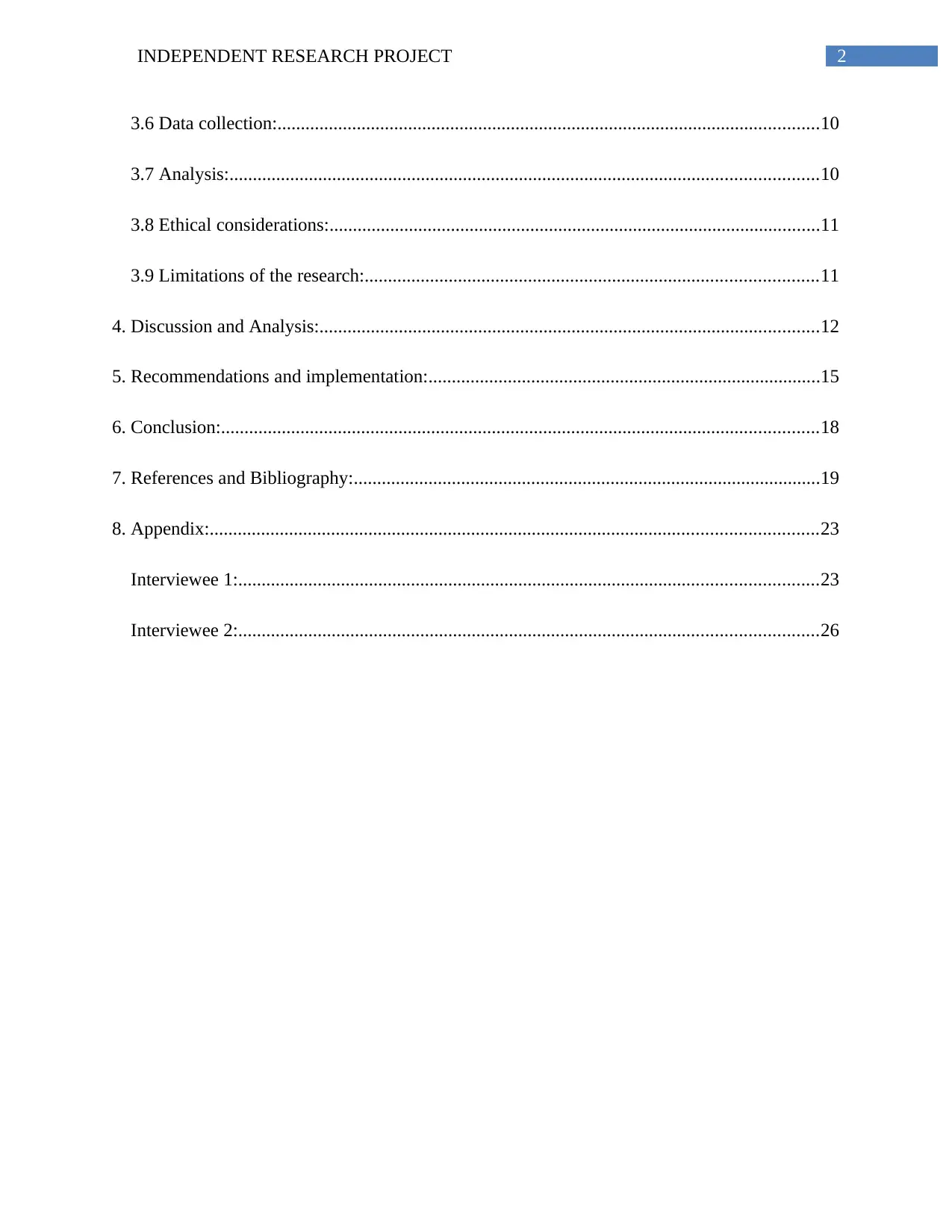
2INDEPENDENT RESEARCH PROJECT
3.6 Data collection:....................................................................................................................10
3.7 Analysis:..............................................................................................................................10
3.8 Ethical considerations:.........................................................................................................11
3.9 Limitations of the research:.................................................................................................11
4. Discussion and Analysis:...........................................................................................................12
5. Recommendations and implementation:....................................................................................15
6. Conclusion:................................................................................................................................18
7. References and Bibliography:....................................................................................................19
8. Appendix:..................................................................................................................................23
Interviewee 1:............................................................................................................................23
Interviewee 2:............................................................................................................................26
3.6 Data collection:....................................................................................................................10
3.7 Analysis:..............................................................................................................................10
3.8 Ethical considerations:.........................................................................................................11
3.9 Limitations of the research:.................................................................................................11
4. Discussion and Analysis:...........................................................................................................12
5. Recommendations and implementation:....................................................................................15
6. Conclusion:................................................................................................................................18
7. References and Bibliography:....................................................................................................19
8. Appendix:..................................................................................................................................23
Interviewee 1:............................................................................................................................23
Interviewee 2:............................................................................................................................26
⊘ This is a preview!⊘
Do you want full access?
Subscribe today to unlock all pages.

Trusted by 1+ million students worldwide
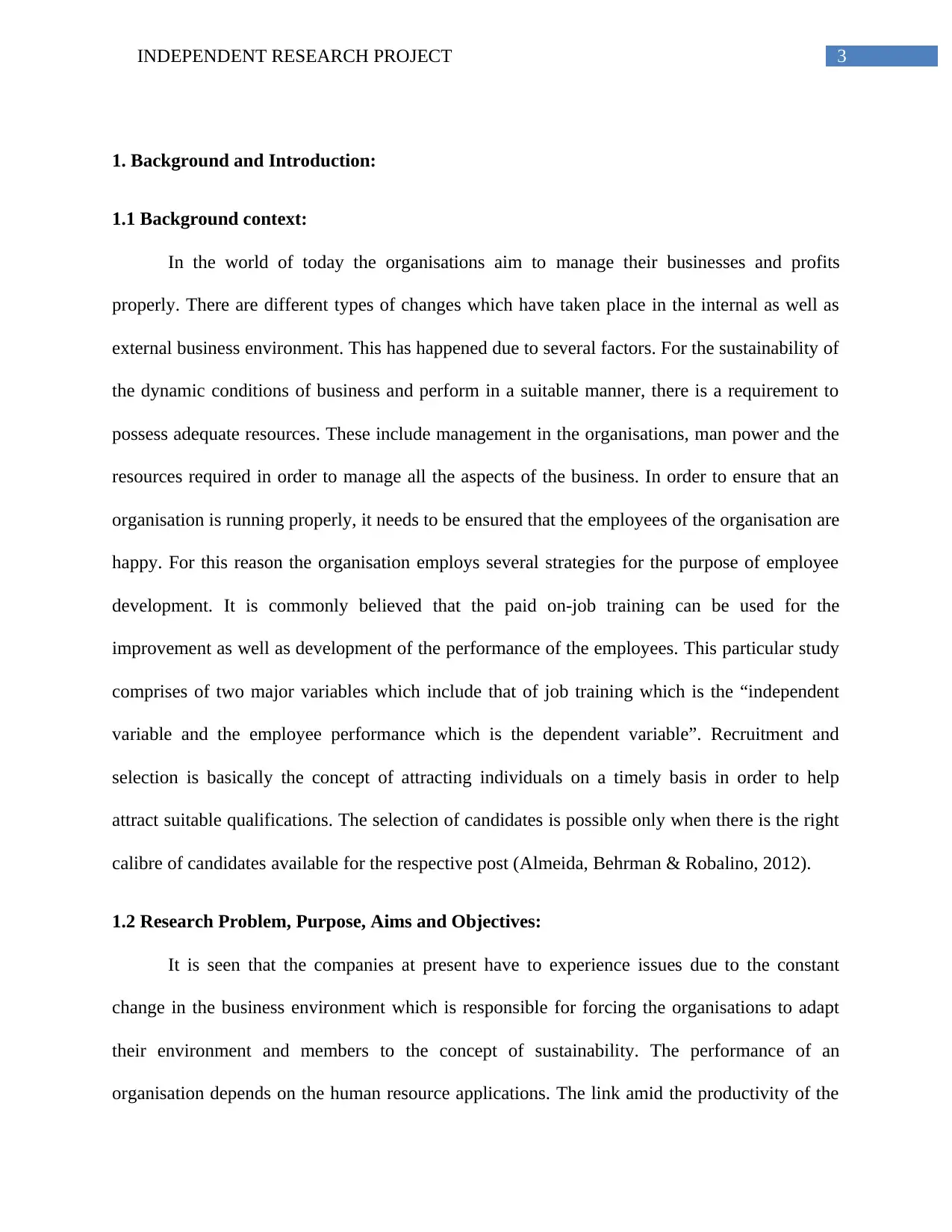
3INDEPENDENT RESEARCH PROJECT
1. Background and Introduction:
1.1 Background context:
In the world of today the organisations aim to manage their businesses and profits
properly. There are different types of changes which have taken place in the internal as well as
external business environment. This has happened due to several factors. For the sustainability of
the dynamic conditions of business and perform in a suitable manner, there is a requirement to
possess adequate resources. These include management in the organisations, man power and the
resources required in order to manage all the aspects of the business. In order to ensure that an
organisation is running properly, it needs to be ensured that the employees of the organisation are
happy. For this reason the organisation employs several strategies for the purpose of employee
development. It is commonly believed that the paid on-job training can be used for the
improvement as well as development of the performance of the employees. This particular study
comprises of two major variables which include that of job training which is the “independent
variable and the employee performance which is the dependent variable”. Recruitment and
selection is basically the concept of attracting individuals on a timely basis in order to help
attract suitable qualifications. The selection of candidates is possible only when there is the right
calibre of candidates available for the respective post (Almeida, Behrman & Robalino, 2012).
1.2 Research Problem, Purpose, Aims and Objectives:
It is seen that the companies at present have to experience issues due to the constant
change in the business environment which is responsible for forcing the organisations to adapt
their environment and members to the concept of sustainability. The performance of an
organisation depends on the human resource applications. The link amid the productivity of the
1. Background and Introduction:
1.1 Background context:
In the world of today the organisations aim to manage their businesses and profits
properly. There are different types of changes which have taken place in the internal as well as
external business environment. This has happened due to several factors. For the sustainability of
the dynamic conditions of business and perform in a suitable manner, there is a requirement to
possess adequate resources. These include management in the organisations, man power and the
resources required in order to manage all the aspects of the business. In order to ensure that an
organisation is running properly, it needs to be ensured that the employees of the organisation are
happy. For this reason the organisation employs several strategies for the purpose of employee
development. It is commonly believed that the paid on-job training can be used for the
improvement as well as development of the performance of the employees. This particular study
comprises of two major variables which include that of job training which is the “independent
variable and the employee performance which is the dependent variable”. Recruitment and
selection is basically the concept of attracting individuals on a timely basis in order to help
attract suitable qualifications. The selection of candidates is possible only when there is the right
calibre of candidates available for the respective post (Almeida, Behrman & Robalino, 2012).
1.2 Research Problem, Purpose, Aims and Objectives:
It is seen that the companies at present have to experience issues due to the constant
change in the business environment which is responsible for forcing the organisations to adapt
their environment and members to the concept of sustainability. The performance of an
organisation depends on the human resource applications. The link amid the productivity of the
Paraphrase This Document
Need a fresh take? Get an instant paraphrase of this document with our AI Paraphraser
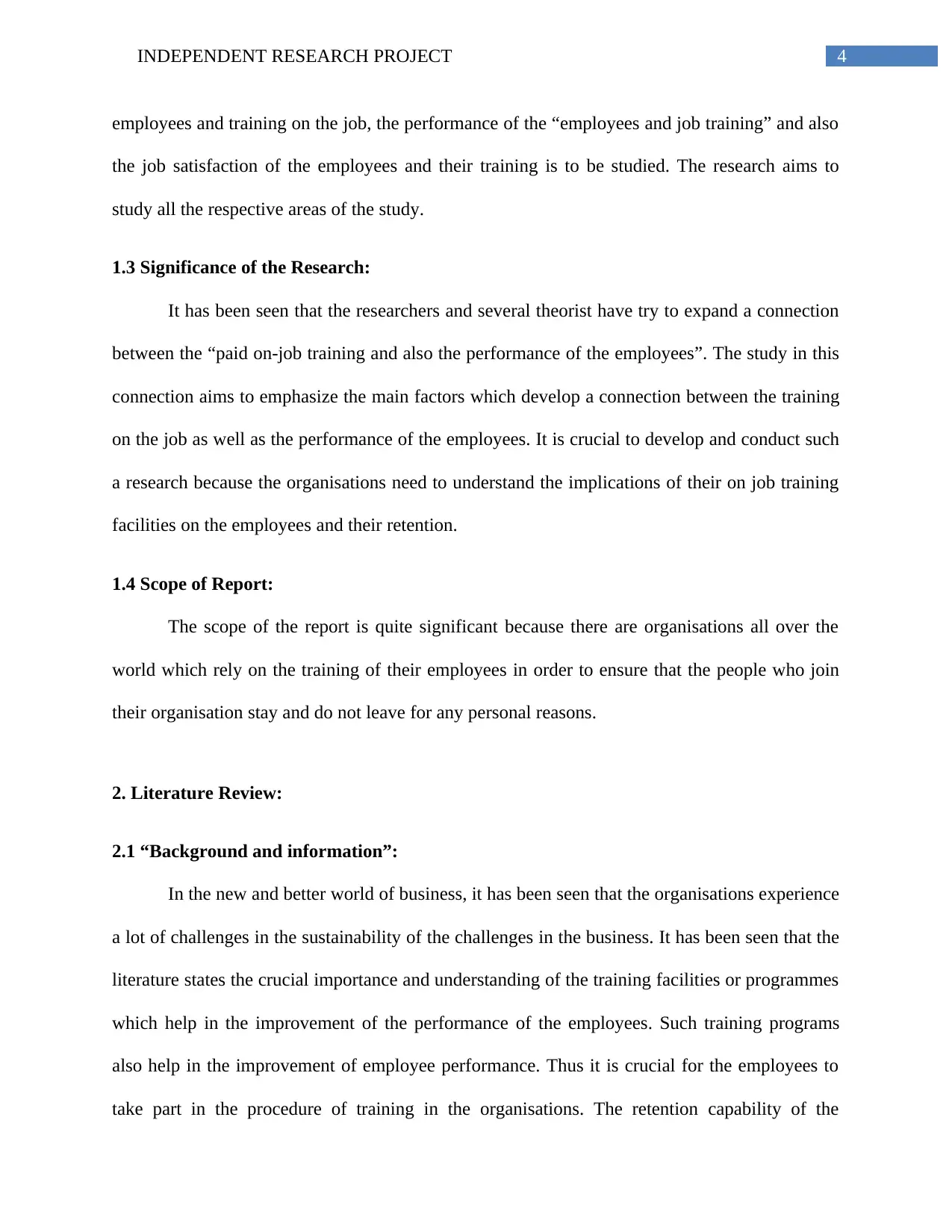
4INDEPENDENT RESEARCH PROJECT
employees and training on the job, the performance of the “employees and job training” and also
the job satisfaction of the employees and their training is to be studied. The research aims to
study all the respective areas of the study.
1.3 Significance of the Research:
It has been seen that the researchers and several theorist have try to expand a connection
between the “paid on-job training and also the performance of the employees”. The study in this
connection aims to emphasize the main factors which develop a connection between the training
on the job as well as the performance of the employees. It is crucial to develop and conduct such
a research because the organisations need to understand the implications of their on job training
facilities on the employees and their retention.
1.4 Scope of Report:
The scope of the report is quite significant because there are organisations all over the
world which rely on the training of their employees in order to ensure that the people who join
their organisation stay and do not leave for any personal reasons.
2. Literature Review:
2.1 “Background and information”:
In the new and better world of business, it has been seen that the organisations experience
a lot of challenges in the sustainability of the challenges in the business. It has been seen that the
literature states the crucial importance and understanding of the training facilities or programmes
which help in the improvement of the performance of the employees. Such training programs
also help in the improvement of employee performance. Thus it is crucial for the employees to
take part in the procedure of training in the organisations. The retention capability of the
employees and training on the job, the performance of the “employees and job training” and also
the job satisfaction of the employees and their training is to be studied. The research aims to
study all the respective areas of the study.
1.3 Significance of the Research:
It has been seen that the researchers and several theorist have try to expand a connection
between the “paid on-job training and also the performance of the employees”. The study in this
connection aims to emphasize the main factors which develop a connection between the training
on the job as well as the performance of the employees. It is crucial to develop and conduct such
a research because the organisations need to understand the implications of their on job training
facilities on the employees and their retention.
1.4 Scope of Report:
The scope of the report is quite significant because there are organisations all over the
world which rely on the training of their employees in order to ensure that the people who join
their organisation stay and do not leave for any personal reasons.
2. Literature Review:
2.1 “Background and information”:
In the new and better world of business, it has been seen that the organisations experience
a lot of challenges in the sustainability of the challenges in the business. It has been seen that the
literature states the crucial importance and understanding of the training facilities or programmes
which help in the improvement of the performance of the employees. Such training programs
also help in the improvement of employee performance. Thus it is crucial for the employees to
take part in the procedure of training in the organisations. The retention capability of the
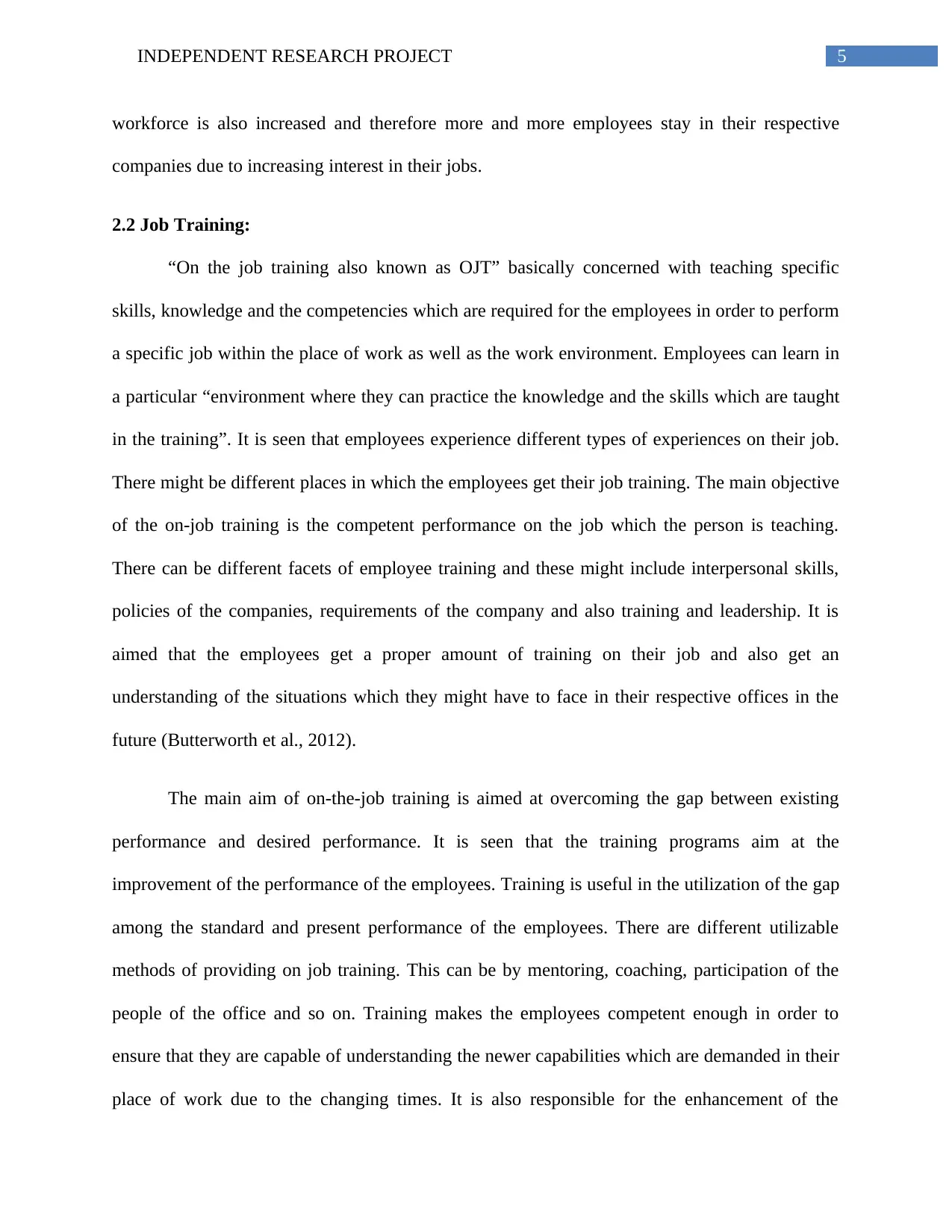
5INDEPENDENT RESEARCH PROJECT
workforce is also increased and therefore more and more employees stay in their respective
companies due to increasing interest in their jobs.
2.2 Job Training:
“On the job training also known as OJT” basically concerned with teaching specific
skills, knowledge and the competencies which are required for the employees in order to perform
a specific job within the place of work as well as the work environment. Employees can learn in
a particular “environment where they can practice the knowledge and the skills which are taught
in the training”. It is seen that employees experience different types of experiences on their job.
There might be different places in which the employees get their job training. The main objective
of the on-job training is the competent performance on the job which the person is teaching.
There can be different facets of employee training and these might include interpersonal skills,
policies of the companies, requirements of the company and also training and leadership. It is
aimed that the employees get a proper amount of training on their job and also get an
understanding of the situations which they might have to face in their respective offices in the
future (Butterworth et al., 2012).
The main aim of on-the-job training is aimed at overcoming the gap between existing
performance and desired performance. It is seen that the training programs aim at the
improvement of the performance of the employees. Training is useful in the utilization of the gap
among the standard and present performance of the employees. There are different utilizable
methods of providing on job training. This can be by mentoring, coaching, participation of the
people of the office and so on. Training makes the employees competent enough in order to
ensure that they are capable of understanding the newer capabilities which are demanded in their
place of work due to the changing times. It is also responsible for the enhancement of the
workforce is also increased and therefore more and more employees stay in their respective
companies due to increasing interest in their jobs.
2.2 Job Training:
“On the job training also known as OJT” basically concerned with teaching specific
skills, knowledge and the competencies which are required for the employees in order to perform
a specific job within the place of work as well as the work environment. Employees can learn in
a particular “environment where they can practice the knowledge and the skills which are taught
in the training”. It is seen that employees experience different types of experiences on their job.
There might be different places in which the employees get their job training. The main objective
of the on-job training is the competent performance on the job which the person is teaching.
There can be different facets of employee training and these might include interpersonal skills,
policies of the companies, requirements of the company and also training and leadership. It is
aimed that the employees get a proper amount of training on their job and also get an
understanding of the situations which they might have to face in their respective offices in the
future (Butterworth et al., 2012).
The main aim of on-the-job training is aimed at overcoming the gap between existing
performance and desired performance. It is seen that the training programs aim at the
improvement of the performance of the employees. Training is useful in the utilization of the gap
among the standard and present performance of the employees. There are different utilizable
methods of providing on job training. This can be by mentoring, coaching, participation of the
people of the office and so on. Training makes the employees competent enough in order to
ensure that they are capable of understanding the newer capabilities which are demanded in their
place of work due to the changing times. It is also responsible for the enhancement of the
⊘ This is a preview!⊘
Do you want full access?
Subscribe today to unlock all pages.

Trusted by 1+ million students worldwide
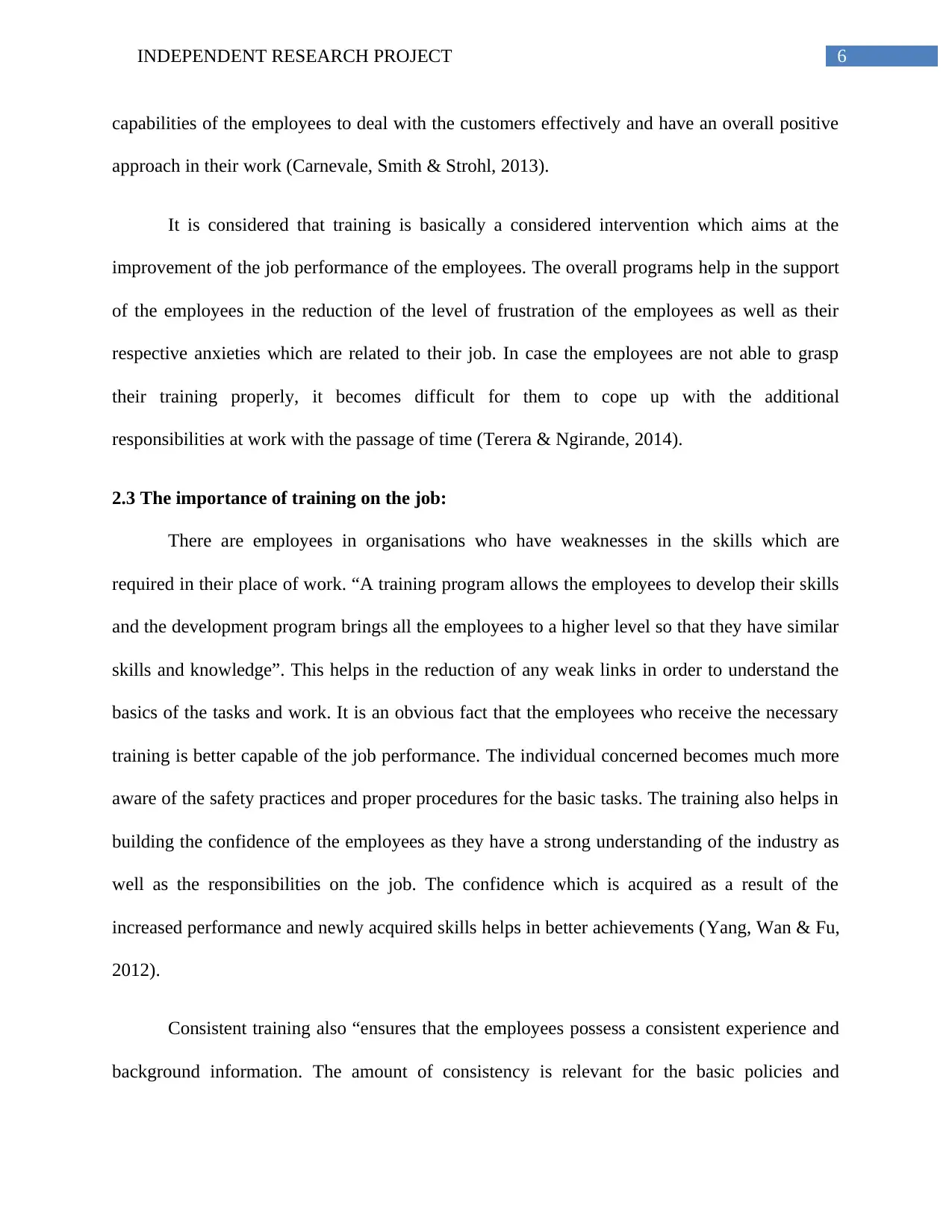
6INDEPENDENT RESEARCH PROJECT
capabilities of the employees to deal with the customers effectively and have an overall positive
approach in their work (Carnevale, Smith & Strohl, 2013).
It is considered that training is basically a considered intervention which aims at the
improvement of the job performance of the employees. The overall programs help in the support
of the employees in the reduction of the level of frustration of the employees as well as their
respective anxieties which are related to their job. In case the employees are not able to grasp
their training properly, it becomes difficult for them to cope up with the additional
responsibilities at work with the passage of time (Terera & Ngirande, 2014).
2.3 The importance of training on the job:
There are employees in organisations who have weaknesses in the skills which are
required in their place of work. “A training program allows the employees to develop their skills
and the development program brings all the employees to a higher level so that they have similar
skills and knowledge”. This helps in the reduction of any weak links in order to understand the
basics of the tasks and work. It is an obvious fact that the employees who receive the necessary
training is better capable of the job performance. The individual concerned becomes much more
aware of the safety practices and proper procedures for the basic tasks. The training also helps in
building the confidence of the employees as they have a strong understanding of the industry as
well as the responsibilities on the job. The confidence which is acquired as a result of the
increased performance and newly acquired skills helps in better achievements (Yang, Wan & Fu,
2012).
Consistent training also “ensures that the employees possess a consistent experience and
background information. The amount of consistency is relevant for the basic policies and
capabilities of the employees to deal with the customers effectively and have an overall positive
approach in their work (Carnevale, Smith & Strohl, 2013).
It is considered that training is basically a considered intervention which aims at the
improvement of the job performance of the employees. The overall programs help in the support
of the employees in the reduction of the level of frustration of the employees as well as their
respective anxieties which are related to their job. In case the employees are not able to grasp
their training properly, it becomes difficult for them to cope up with the additional
responsibilities at work with the passage of time (Terera & Ngirande, 2014).
2.3 The importance of training on the job:
There are employees in organisations who have weaknesses in the skills which are
required in their place of work. “A training program allows the employees to develop their skills
and the development program brings all the employees to a higher level so that they have similar
skills and knowledge”. This helps in the reduction of any weak links in order to understand the
basics of the tasks and work. It is an obvious fact that the employees who receive the necessary
training is better capable of the job performance. The individual concerned becomes much more
aware of the safety practices and proper procedures for the basic tasks. The training also helps in
building the confidence of the employees as they have a strong understanding of the industry as
well as the responsibilities on the job. The confidence which is acquired as a result of the
increased performance and newly acquired skills helps in better achievements (Yang, Wan & Fu,
2012).
Consistent training also “ensures that the employees possess a consistent experience and
background information. The amount of consistency is relevant for the basic policies and
Paraphrase This Document
Need a fresh take? Get an instant paraphrase of this document with our AI Paraphraser
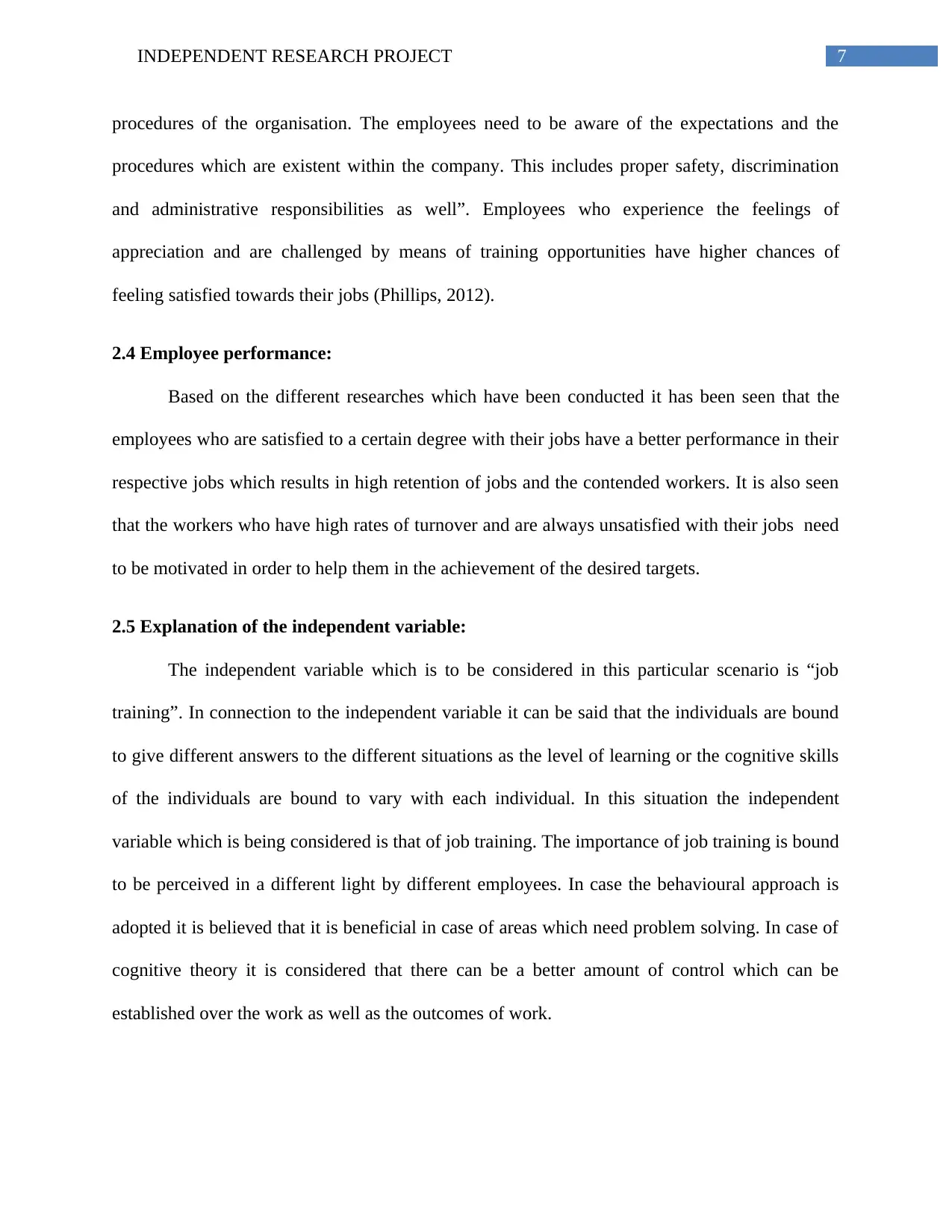
7INDEPENDENT RESEARCH PROJECT
procedures of the organisation. The employees need to be aware of the expectations and the
procedures which are existent within the company. This includes proper safety, discrimination
and administrative responsibilities as well”. Employees who experience the feelings of
appreciation and are challenged by means of training opportunities have higher chances of
feeling satisfied towards their jobs (Phillips, 2012).
2.4 Employee performance:
Based on the different researches which have been conducted it has been seen that the
employees who are satisfied to a certain degree with their jobs have a better performance in their
respective jobs which results in high retention of jobs and the contended workers. It is also seen
that the workers who have high rates of turnover and are always unsatisfied with their jobs need
to be motivated in order to help them in the achievement of the desired targets.
2.5 Explanation of the independent variable:
The independent variable which is to be considered in this particular scenario is “job
training”. In connection to the independent variable it can be said that the individuals are bound
to give different answers to the different situations as the level of learning or the cognitive skills
of the individuals are bound to vary with each individual. In this situation the independent
variable which is being considered is that of job training. The importance of job training is bound
to be perceived in a different light by different employees. In case the behavioural approach is
adopted it is believed that it is beneficial in case of areas which need problem solving. In case of
cognitive theory it is considered that there can be a better amount of control which can be
established over the work as well as the outcomes of work.
procedures of the organisation. The employees need to be aware of the expectations and the
procedures which are existent within the company. This includes proper safety, discrimination
and administrative responsibilities as well”. Employees who experience the feelings of
appreciation and are challenged by means of training opportunities have higher chances of
feeling satisfied towards their jobs (Phillips, 2012).
2.4 Employee performance:
Based on the different researches which have been conducted it has been seen that the
employees who are satisfied to a certain degree with their jobs have a better performance in their
respective jobs which results in high retention of jobs and the contended workers. It is also seen
that the workers who have high rates of turnover and are always unsatisfied with their jobs need
to be motivated in order to help them in the achievement of the desired targets.
2.5 Explanation of the independent variable:
The independent variable which is to be considered in this particular scenario is “job
training”. In connection to the independent variable it can be said that the individuals are bound
to give different answers to the different situations as the level of learning or the cognitive skills
of the individuals are bound to vary with each individual. In this situation the independent
variable which is being considered is that of job training. The importance of job training is bound
to be perceived in a different light by different employees. In case the behavioural approach is
adopted it is believed that it is beneficial in case of areas which need problem solving. In case of
cognitive theory it is considered that there can be a better amount of control which can be
established over the work as well as the outcomes of work.
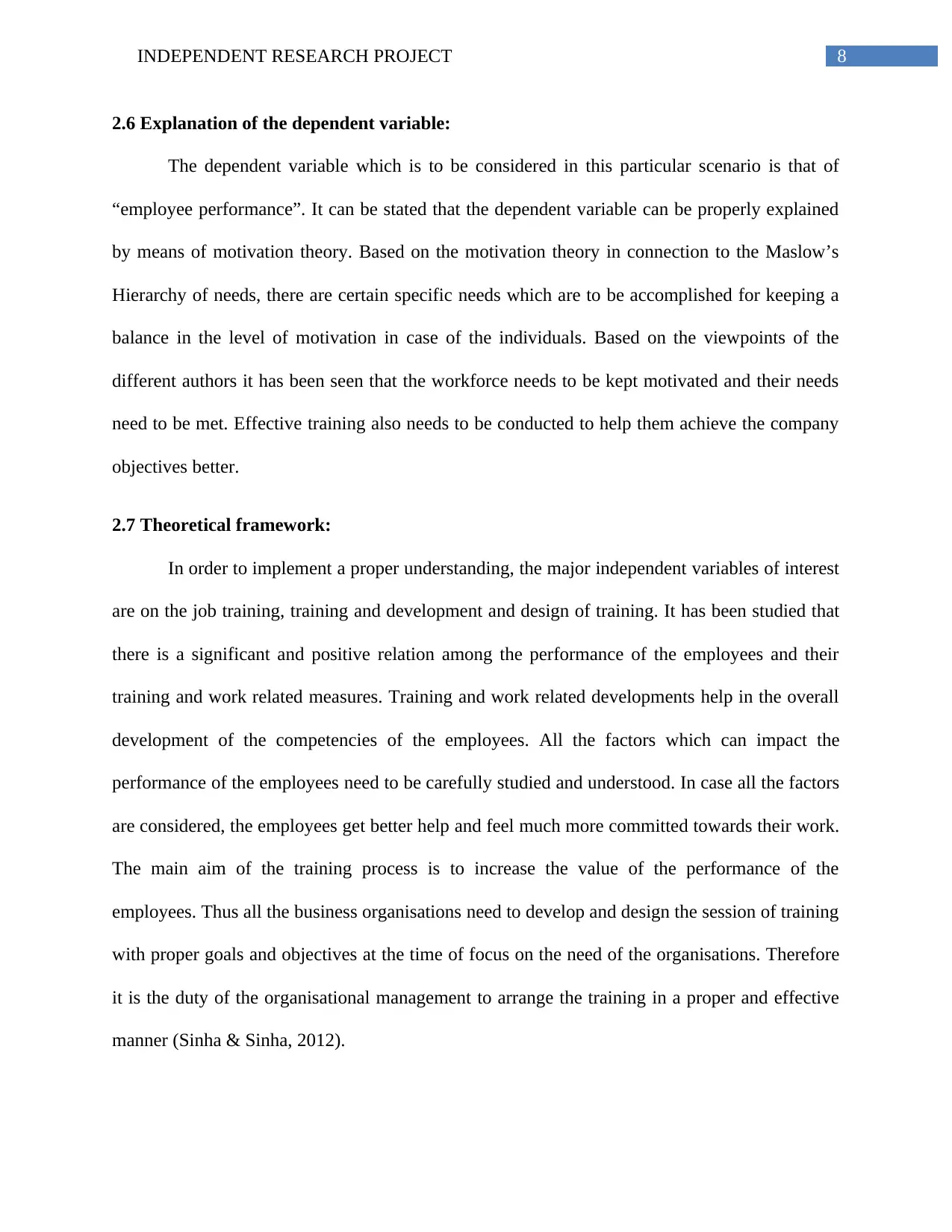
8INDEPENDENT RESEARCH PROJECT
2.6 Explanation of the dependent variable:
The dependent variable which is to be considered in this particular scenario is that of
“employee performance”. It can be stated that the dependent variable can be properly explained
by means of motivation theory. Based on the motivation theory in connection to the Maslow’s
Hierarchy of needs, there are certain specific needs which are to be accomplished for keeping a
balance in the level of motivation in case of the individuals. Based on the viewpoints of the
different authors it has been seen that the workforce needs to be kept motivated and their needs
need to be met. Effective training also needs to be conducted to help them achieve the company
objectives better.
2.7 Theoretical framework:
In order to implement a proper understanding, the major independent variables of interest
are on the job training, training and development and design of training. It has been studied that
there is a significant and positive relation among the performance of the employees and their
training and work related measures. Training and work related developments help in the overall
development of the competencies of the employees. All the factors which can impact the
performance of the employees need to be carefully studied and understood. In case all the factors
are considered, the employees get better help and feel much more committed towards their work.
The main aim of the training process is to increase the value of the performance of the
employees. Thus all the business organisations need to develop and design the session of training
with proper goals and objectives at the time of focus on the need of the organisations. Therefore
it is the duty of the organisational management to arrange the training in a proper and effective
manner (Sinha & Sinha, 2012).
2.6 Explanation of the dependent variable:
The dependent variable which is to be considered in this particular scenario is that of
“employee performance”. It can be stated that the dependent variable can be properly explained
by means of motivation theory. Based on the motivation theory in connection to the Maslow’s
Hierarchy of needs, there are certain specific needs which are to be accomplished for keeping a
balance in the level of motivation in case of the individuals. Based on the viewpoints of the
different authors it has been seen that the workforce needs to be kept motivated and their needs
need to be met. Effective training also needs to be conducted to help them achieve the company
objectives better.
2.7 Theoretical framework:
In order to implement a proper understanding, the major independent variables of interest
are on the job training, training and development and design of training. It has been studied that
there is a significant and positive relation among the performance of the employees and their
training and work related measures. Training and work related developments help in the overall
development of the competencies of the employees. All the factors which can impact the
performance of the employees need to be carefully studied and understood. In case all the factors
are considered, the employees get better help and feel much more committed towards their work.
The main aim of the training process is to increase the value of the performance of the
employees. Thus all the business organisations need to develop and design the session of training
with proper goals and objectives at the time of focus on the need of the organisations. Therefore
it is the duty of the organisational management to arrange the training in a proper and effective
manner (Sinha & Sinha, 2012).
⊘ This is a preview!⊘
Do you want full access?
Subscribe today to unlock all pages.

Trusted by 1+ million students worldwide
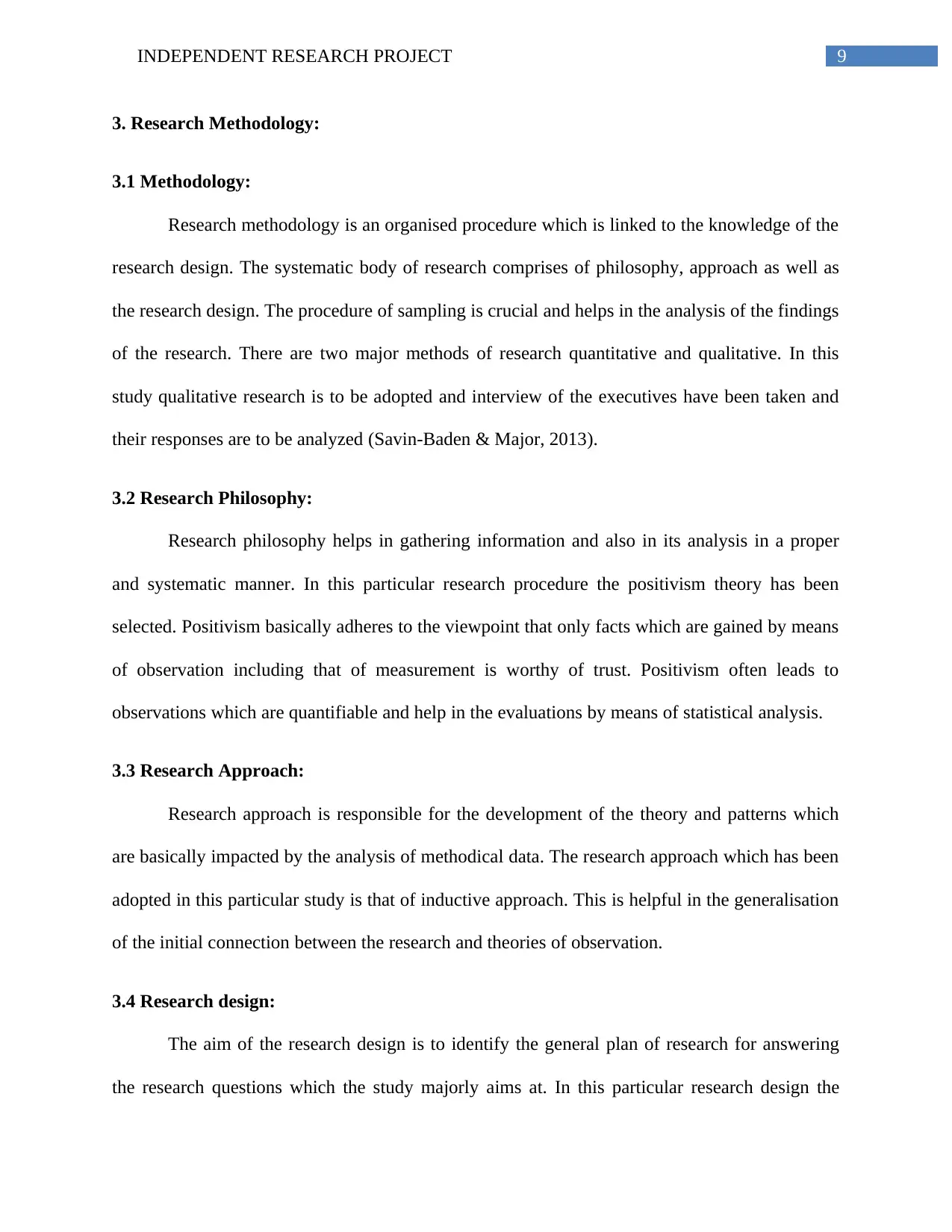
9INDEPENDENT RESEARCH PROJECT
3. Research Methodology:
3.1 Methodology:
Research methodology is an organised procedure which is linked to the knowledge of the
research design. The systematic body of research comprises of philosophy, approach as well as
the research design. The procedure of sampling is crucial and helps in the analysis of the findings
of the research. There are two major methods of research quantitative and qualitative. In this
study qualitative research is to be adopted and interview of the executives have been taken and
their responses are to be analyzed (Savin-Baden & Major, 2013).
3.2 Research Philosophy:
Research philosophy helps in gathering information and also in its analysis in a proper
and systematic manner. In this particular research procedure the positivism theory has been
selected. Positivism basically adheres to the viewpoint that only facts which are gained by means
of observation including that of measurement is worthy of trust. Positivism often leads to
observations which are quantifiable and help in the evaluations by means of statistical analysis.
3.3 Research Approach:
Research approach is responsible for the development of the theory and patterns which
are basically impacted by the analysis of methodical data. The research approach which has been
adopted in this particular study is that of inductive approach. This is helpful in the generalisation
of the initial connection between the research and theories of observation.
3.4 Research design:
The aim of the research design is to identify the general plan of research for answering
the research questions which the study majorly aims at. In this particular research design the
3. Research Methodology:
3.1 Methodology:
Research methodology is an organised procedure which is linked to the knowledge of the
research design. The systematic body of research comprises of philosophy, approach as well as
the research design. The procedure of sampling is crucial and helps in the analysis of the findings
of the research. There are two major methods of research quantitative and qualitative. In this
study qualitative research is to be adopted and interview of the executives have been taken and
their responses are to be analyzed (Savin-Baden & Major, 2013).
3.2 Research Philosophy:
Research philosophy helps in gathering information and also in its analysis in a proper
and systematic manner. In this particular research procedure the positivism theory has been
selected. Positivism basically adheres to the viewpoint that only facts which are gained by means
of observation including that of measurement is worthy of trust. Positivism often leads to
observations which are quantifiable and help in the evaluations by means of statistical analysis.
3.3 Research Approach:
Research approach is responsible for the development of the theory and patterns which
are basically impacted by the analysis of methodical data. The research approach which has been
adopted in this particular study is that of inductive approach. This is helpful in the generalisation
of the initial connection between the research and theories of observation.
3.4 Research design:
The aim of the research design is to identify the general plan of research for answering
the research questions which the study majorly aims at. In this particular research design the
Paraphrase This Document
Need a fresh take? Get an instant paraphrase of this document with our AI Paraphraser
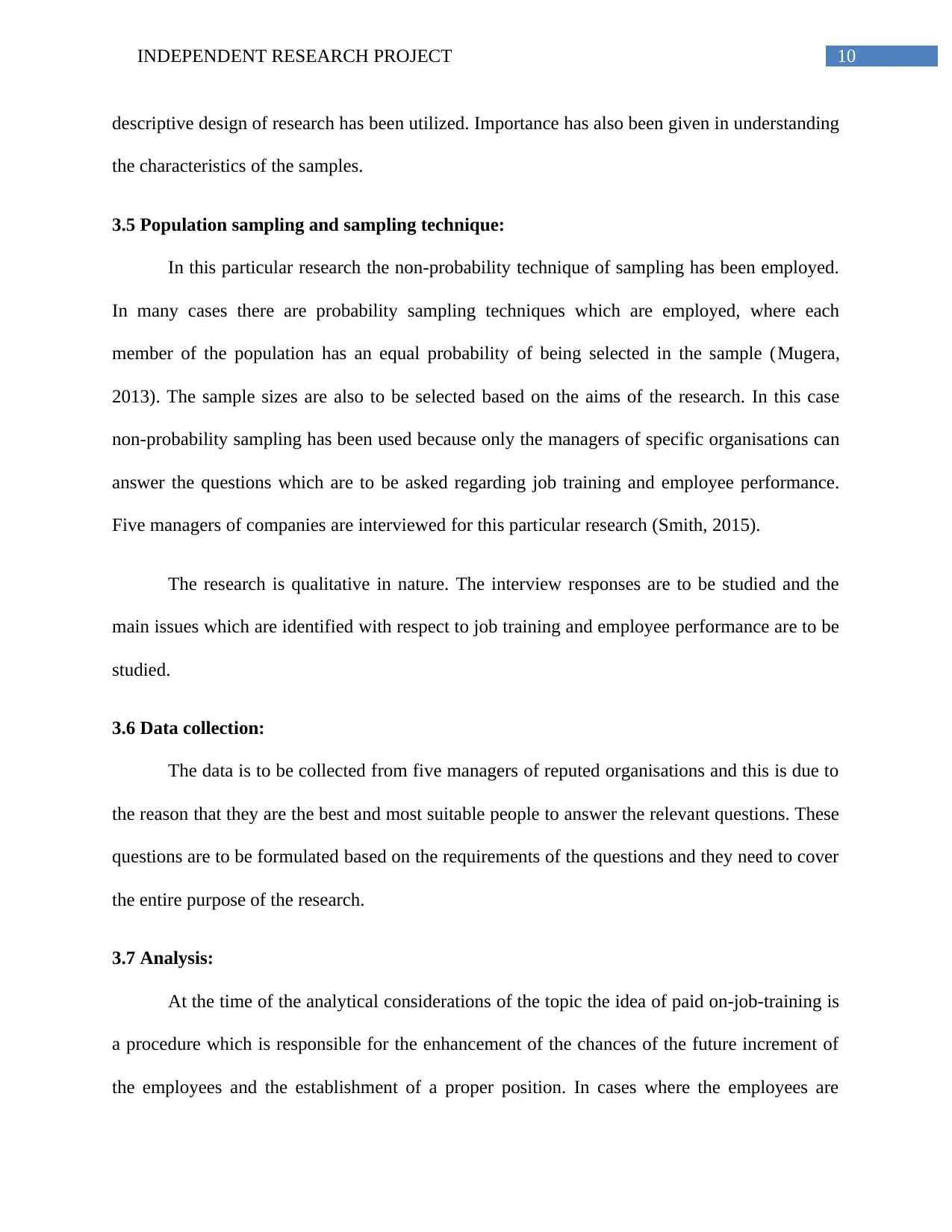
10INDEPENDENT RESEARCH PROJECT
descriptive design of research has been utilized. Importance has also been given in understanding
the characteristics of the samples.
3.5 Population sampling and sampling technique:
In this particular research the non-probability technique of sampling has been employed.
In many cases there are probability sampling techniques which are employed, where each
member of the population has an equal probability of being selected in the sample (Mugera,
2013). The sample sizes are also to be selected based on the aims of the research. In this case
non-probability sampling has been used because only the managers of specific organisations can
answer the questions which are to be asked regarding job training and employee performance.
Five managers of companies are interviewed for this particular research (Smith, 2015).
The research is qualitative in nature. The interview responses are to be studied and the
main issues which are identified with respect to job training and employee performance are to be
studied.
3.6 Data collection:
The data is to be collected from five managers of reputed organisations and this is due to
the reason that they are the best and most suitable people to answer the relevant questions. These
questions are to be formulated based on the requirements of the questions and they need to cover
the entire purpose of the research.
3.7 Analysis:
At the time of the analytical considerations of the topic the idea of paid on-job-training is
a procedure which is responsible for the enhancement of the chances of the future increment of
the employees and the establishment of a proper position. In cases where the employees are
descriptive design of research has been utilized. Importance has also been given in understanding
the characteristics of the samples.
3.5 Population sampling and sampling technique:
In this particular research the non-probability technique of sampling has been employed.
In many cases there are probability sampling techniques which are employed, where each
member of the population has an equal probability of being selected in the sample (Mugera,
2013). The sample sizes are also to be selected based on the aims of the research. In this case
non-probability sampling has been used because only the managers of specific organisations can
answer the questions which are to be asked regarding job training and employee performance.
Five managers of companies are interviewed for this particular research (Smith, 2015).
The research is qualitative in nature. The interview responses are to be studied and the
main issues which are identified with respect to job training and employee performance are to be
studied.
3.6 Data collection:
The data is to be collected from five managers of reputed organisations and this is due to
the reason that they are the best and most suitable people to answer the relevant questions. These
questions are to be formulated based on the requirements of the questions and they need to cover
the entire purpose of the research.
3.7 Analysis:
At the time of the analytical considerations of the topic the idea of paid on-job-training is
a procedure which is responsible for the enhancement of the chances of the future increment of
the employees and the establishment of a proper position. In cases where the employees are
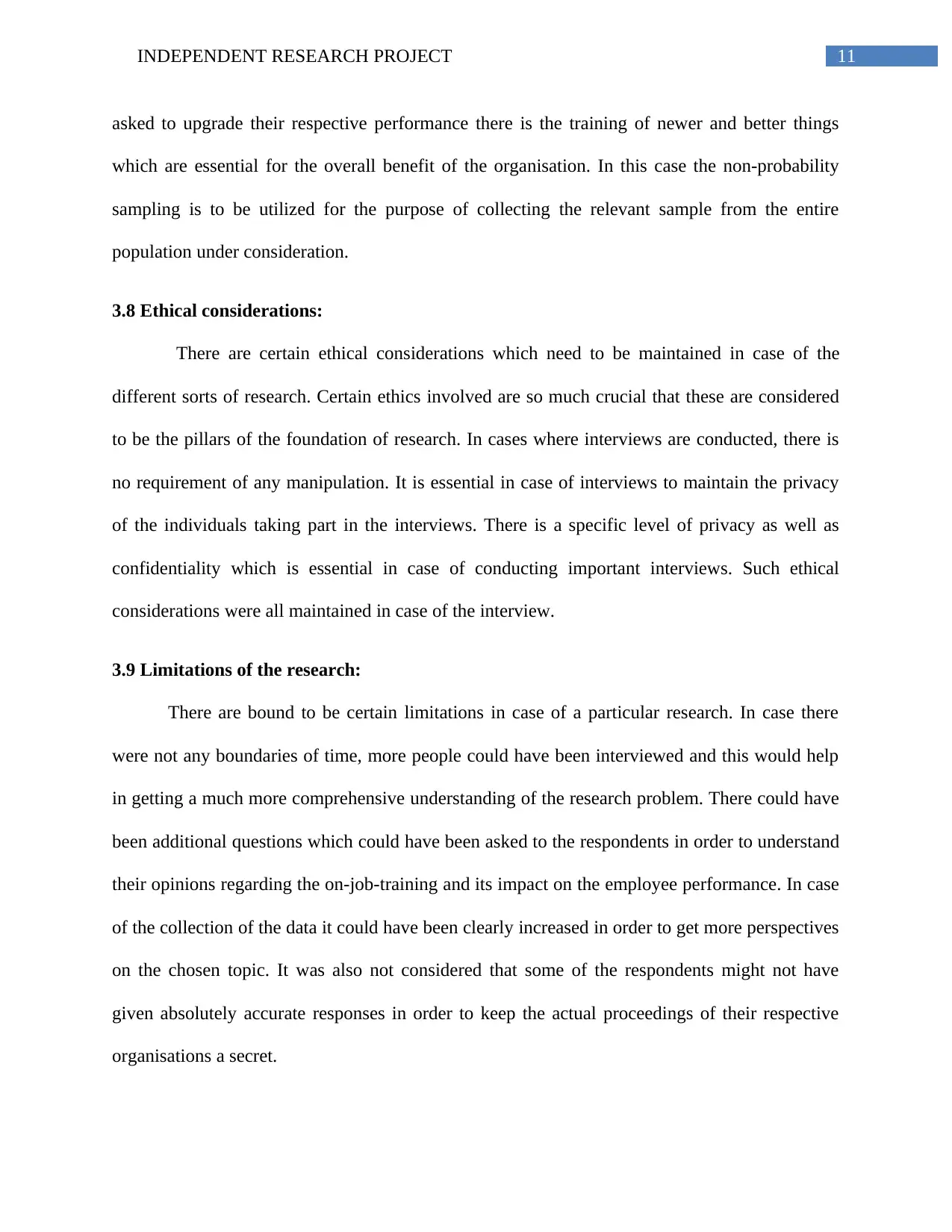
11INDEPENDENT RESEARCH PROJECT
asked to upgrade their respective performance there is the training of newer and better things
which are essential for the overall benefit of the organisation. In this case the non-probability
sampling is to be utilized for the purpose of collecting the relevant sample from the entire
population under consideration.
3.8 Ethical considerations:
There are certain ethical considerations which need to be maintained in case of the
different sorts of research. Certain ethics involved are so much crucial that these are considered
to be the pillars of the foundation of research. In cases where interviews are conducted, there is
no requirement of any manipulation. It is essential in case of interviews to maintain the privacy
of the individuals taking part in the interviews. There is a specific level of privacy as well as
confidentiality which is essential in case of conducting important interviews. Such ethical
considerations were all maintained in case of the interview.
3.9 Limitations of the research:
There are bound to be certain limitations in case of a particular research. In case there
were not any boundaries of time, more people could have been interviewed and this would help
in getting a much more comprehensive understanding of the research problem. There could have
been additional questions which could have been asked to the respondents in order to understand
their opinions regarding the on-job-training and its impact on the employee performance. In case
of the collection of the data it could have been clearly increased in order to get more perspectives
on the chosen topic. It was also not considered that some of the respondents might not have
given absolutely accurate responses in order to keep the actual proceedings of their respective
organisations a secret.
asked to upgrade their respective performance there is the training of newer and better things
which are essential for the overall benefit of the organisation. In this case the non-probability
sampling is to be utilized for the purpose of collecting the relevant sample from the entire
population under consideration.
3.8 Ethical considerations:
There are certain ethical considerations which need to be maintained in case of the
different sorts of research. Certain ethics involved are so much crucial that these are considered
to be the pillars of the foundation of research. In cases where interviews are conducted, there is
no requirement of any manipulation. It is essential in case of interviews to maintain the privacy
of the individuals taking part in the interviews. There is a specific level of privacy as well as
confidentiality which is essential in case of conducting important interviews. Such ethical
considerations were all maintained in case of the interview.
3.9 Limitations of the research:
There are bound to be certain limitations in case of a particular research. In case there
were not any boundaries of time, more people could have been interviewed and this would help
in getting a much more comprehensive understanding of the research problem. There could have
been additional questions which could have been asked to the respondents in order to understand
their opinions regarding the on-job-training and its impact on the employee performance. In case
of the collection of the data it could have been clearly increased in order to get more perspectives
on the chosen topic. It was also not considered that some of the respondents might not have
given absolutely accurate responses in order to keep the actual proceedings of their respective
organisations a secret.
⊘ This is a preview!⊘
Do you want full access?
Subscribe today to unlock all pages.

Trusted by 1+ million students worldwide
1 out of 30
Related Documents
Your All-in-One AI-Powered Toolkit for Academic Success.
+13062052269
info@desklib.com
Available 24*7 on WhatsApp / Email
![[object Object]](/_next/static/media/star-bottom.7253800d.svg)
Unlock your academic potential
Copyright © 2020–2025 A2Z Services. All Rights Reserved. Developed and managed by ZUCOL.




